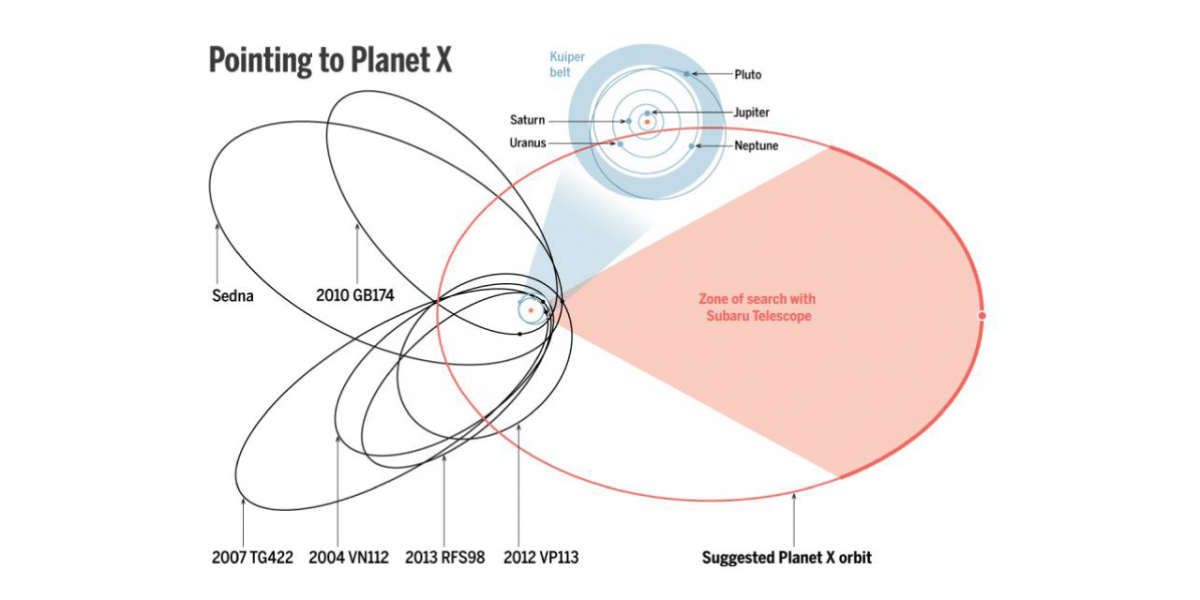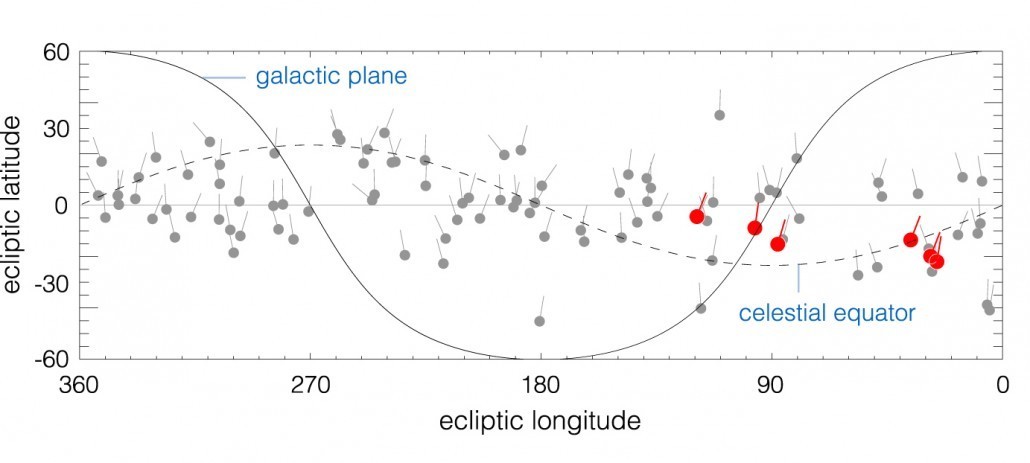In the 1800s observations of the planet Uranus had some interesting irregularities. When compared against the predicted motion of Uranus due to the Sun and other planets, the actual motion didn’t quite match. This led some astronomers to suspect that there was another planet beyond Uranus. In 1846 Neptune was discovered close to its predicted position. Now a new paper in the Astronomical Journal, points to similar evidence that a large planet may lurk in our outer solar system.
The evidence comes from the behavior of the outermost known solar system bodies (the six with an average distance greater than 250 AU). These bodies are so distant from the Sun that we can’t measure their gravitational deviation directly. We just haven’t observed their orbits well enough. So instead the authors of this new work looked at the statistical characteristics of the bodies.
If one assumes the orbits of outer solar system bodies are Keplerian (which is a reasonable assumption) then you can plot them in terms of their orientation. Most of the outer solar system bodies are distributed fairly randomly, but the most distant ones are clustered. Their orbits seemed to be clumped together in a way that you wouldn’t otherwise expect. The authors calculate the likelihood of this happening purely by chance is about 0.007%. In scientific terms that’s not quite unusual enough to be conclusive, but it does strongly hint at either a bias in the way these outer bodies are discovered or a mechanism that has caused them to cluster.
The authors contend that a good explanation for the clustering is a gravitational perturbation by a Neptune-mass planet further away and on the other side of the solar system. While it’s certainly a good explanation for the clustering of these outer bodies, that doesn’t guarantee there’s a large world out there. There are other possible explanations that could account for the effect. But it is worth looking into, and that’s exactly what’s planned. If there is a planet out there, then infrared sky surveys such as NEOWISE have a chance of finding it.
Paper: Konstantin Batygin and Michael E. Brown. Evidence for a Distant Giant Planet in the Solar System. The Astronomical Journal, Volume 151, Number 2 (2016)













Comments
what/are/the/other/six/bodies/called?
They are dwarf planets or detached objects. If you look at the labels on the top graphic most of the labels have Wikipedia pages.
This paper is getting a lot of publicity. It will be interesting to see whether the the sky surveys can locate something. Speculation is that Pluto is 10,000 times brighter “Planet Nine”. Not sure whether that guess applies only to visible light.
I think,i more finite definition of what a planet is will be needed before we can truly call this one. Otherwise we would also need to reinclude Pluto making #9.
Are current measurements of the motions of nearby stars accurate enough to extrapolate backwards and calculate (possibly statistically) their close passages to our system? And the resulting gravitational influences?
If there is a large planet out there, it is NOT the ninth planet but more like the 15th. In referring to this potential object as “Planet Nine,” Brown is being extremely disingenuous by portraying his view of the solar system and planet definition as THE view when this is far from the case. He is once again promoting his obsession that he somehow “killed” planet Pluto.
It is unfortunate that the media repeat his position without acknowledging the reality is that the IAU definition is just one among many currently in use.
Numerous planetary scientists continue to reject the controversial IAU planet definition, which was adopted by only four percent of the organization, most of whom were not planetary scientists but other types of astronomers. That petition was immediately rejected by hundreds of professional astronomers, who reject the notion that an object has to clear its orbit to be a planet.
Brown deliberately chose the term “ninth planet” knowing it would be repeated ad nauseam by the media, most of whom simply rewrite what is written in the press release.
Dwarf planets ARE planets too, and their discovery means that far more than two full planets have been discovered in the last two centuries. The solar system’s current planets are Mercury, Venus, Earth, Mars, Ceres, Jupiter, Saturn, Uranus, Neptune, Pluto, Charon, Haumea, Makemake, and Eris–and counting.
Regardless of the controversy, there are currently 8 official planets in the solar system. Calling this a possible 9th planet is perfectly acceptable. Given it’s hypothetical size it would not be a dwarf planet, and would add to the current 8. You may not like the current planet definition, but it is in no way disingenuous to use the current definition.
Hi Brian.
Where did you get the diagram showing the “Zone of Search” with the Subaru Telescope?
The paper doesn’t seem to mention this.
Do they have any reason to suspect that it is presently in this part of its orbit, other than the fact that objects spend more time near aphelion than perihelion?
Here’s a simulation I made to show just how slowly “Planet 9” moves against the background stars. It’s movement is much more parallax than its own motion. I placed the planet near perihelion to maximize the motion.
https://twitter.com/tony873004/status/690393769229819904
Good search for the Giant Planet in the Solar System but you need to search mostly in the Entry Milky Way.There is to much interesting I hope one day you going to find same thing